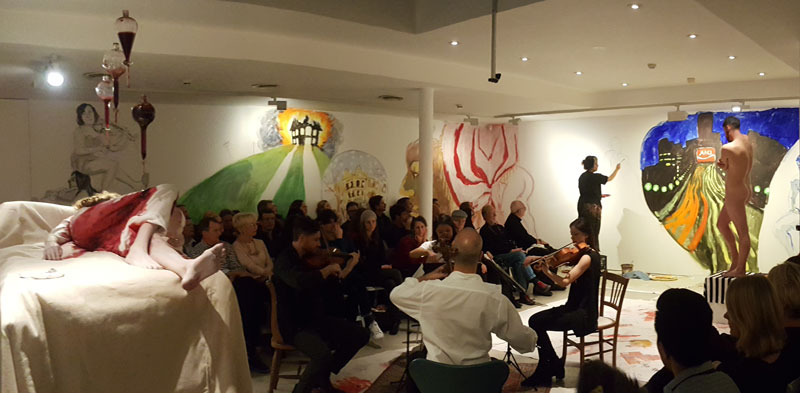★★★½☆ Art, nudity and music make this multi-sensory event come alive.
Yellow House, Sydney
August 5, 2016
It was hard to know where to look, what with a stark naked composer disporting himself, a significant artist sketching him on a wall, and a string quartet sawing away. To cap it off, Clementine Robertson was lying on a plinth the height of an upright piano, dressed in white, with whitened skin and white face mask, while four vials dripped (hopefully) fake blood on her.
This, of course, is not the usual context in which a string quartet plies its trade, and the point was to hint at the daring and decadence of a Belle Époque salon, the Yellow House’s long and arty history in Kings Cross aiding the cause. So where most composers opt to bare their souls rather than their bodies, in Butt Naked Salon Andrew Batt-Rawden (publisher of Limelight) did both, posing nude for Wendy Sharpe. The Australian Art Quartet, meanwhile, opened with his 27, a short autobiographical piece about being that age, in which harmonies soured and tonal colour was in constant flux.

In this version of the AAQ Dan Russell (violin I) and James Beck (cello) were joined by guests Kelly Tang (violin II) and Alina Zamfir (viola), and the second piece came straight from the Belle Époque: Ravel’s String Quartet in F Major, written when the composer was 28. This instantly engaging work has Ravel marshalling his themes in the opening sonata-form movement so that seeming predictability gives way to sudden explosions of the unexpected, although here some of that intent was clouded by minor imprecisions in the phrasing.
The players compensated by achieving the requisite fizzing quality in the second movement’s opening pizzicato section, which acted as a launch pad for the lyrical arco parts, even if the dynamic range seemed somewhat compressed. The harp-like effect of the later pizzicato section was a highlight, as were the glorious opening viola melody to the third movement and the vigour of the fourth, despite some trifling intonation issues.
Call it typecasting, but it somehow tests one’s imagination to picture Elgar in a decadent salon, although his music managed to squeeze through the door in the form of his Chanson de Martin and Chanson de Nuit, both exemplifying his odd combination of stiff formality, pastoral idealism and ravishing melodies.
Then came – with all due respect to Ravel, Elgar, Batt-Rawden (composition and body), Sharpe’s painting and Robertson’s living sculpture – the main event: Shostakovich’s String Quartet in F Major, Opus 73. Seventy years after it was written it retains an enticing ambiguity. Is, for instance, the gaiety of the first movement real or ironic? Here it was certainly the latter, with an almost zany edge creeping into the performance. The AAQ opted to reapply the subtitles to the movements that Shostakovich used at the work’s post-war premiere, then removed, so we had Blithe ignorance in the face of the future cataclysm followed by Rumblings of unrest and anticipation, Forces of war unleashed, In memory of the dead and The eternal question: Why? And for what?. Inevitably the composer’s inclination to treat the war as a tragic disaster rather than an unmitigated triumph hardly sat well with Stalin and his cronies.
To these ears the work really comes alive with the second movement, when a shadow passes across the music, and you feel it shiver; a disquiet initially expressed by the viola. The gripping intensity of this piece immediately had the quartet sounding more sonorous than at any time in the night, and then in the third movement they unleashed their most primal playing, only slightly compromised by tiny errors of timing. As the movement progressed, however, their cohesion became impeccable, as if they had been drawn into the swirling maelstrom of this remarkable piece. The fourth movement’s mood stretches from grief to shell-shocked desolation, and here Russell achieved an exquisite translucence in his violin’s upper register, before the unsettling enigma of the final movement.
By now Robertson was thoroughly bloodstained – much like the Russian army after World War II. Meanwhile four Batt-Rawdens had appeared upon the wall: two in yellow (one bold, one jovial) and two in blue (one pensive, one puzzled and demur). It was enchanting to watch the gifted Sharpe at work, but once Shostakovich came along all else seemed a distraction. Nonetheless it was a marvellous way to make a multi-sensory event come alive.











Comments
Log in to join the conversation.